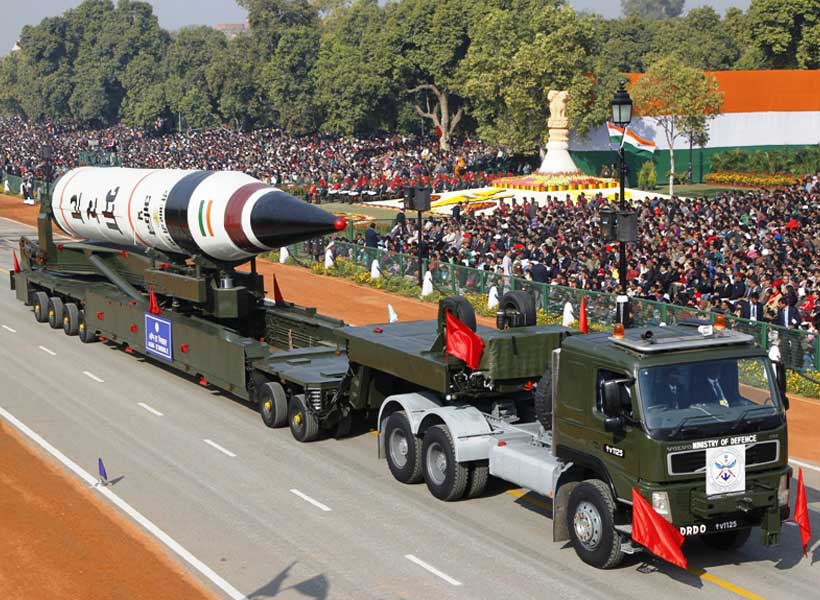
Syeda Saiqa Bukhari 26 April 2019
South Asia is one of the most instable regions in the world because of the ever growing hostility between Pakistan and India. Since partition India has always tried to dominate the region due to its conventional superiority over Pakistan. The bilateral relations of Pakistan and India arebased on distrust and uncertainty. Consequently, Pakistan’s major security threat perceptions are always inclined towards its Eastern border i.e. India.
The current Indian military developments and intention to purchase advanced weaponry have disturbed the existing strategic stability of the region. These developments includeinduction of 05 Dhanushartillery guns (indigenous) and launch ofElectronic Management Intelligence Satellite ‘EMISAT’. Moreover, according to a media report, India has also recently ordered 240 Spike medium range Anti-Tank Guided Missiles (ATGM) and 12 launchersas an emergency purchase fromIsraelin wake of the recent military escalation with Pakistan. Spikeis a medium range multipurpose weapon, having a capability to hit and completely destroy the heavy military armored vehicles. It has a fire and forget mode which enables it to lock ontothe target before it fires instead of acquiring it once the missile is in the air.The missile can be launchedfrom anywhere i.e. air, land or sea. Indian Army has a requirement of around 68, 000 anti-tank guided missiles and 850 launchers of various types. In February 2019 India-Pakistan crisis, Indian response showed that it lacks in terms of advanced military weaponry and efficient response capabilities. In this scenario, the emergency purchase ATGM is significant and somehow it immediately fulfills the operational requirements of Indian offensive military capabilities.
Likewise, Indian Ordnance Factory Board (OFB) developed Dhanush artillery guns with the intention to deploy them along the Pakistani border. These Artillery guns have the capability to perform equally well during the day and night operations. India army places the order of 114 Dhanush guns to OFB, out of which first five guns were handed over to Indian Military on 26th March 2019. Acquiring these artillery guns will enable India to launch swift action against Pakistan in pursuit of its Cold Start Doctrine (CSD). Dhanush gun and anti-tank guided missile will boost the military fire power capability of India against adversary forces which is also the requirement of Indian offensive military doctrine.
On April 1, 2019 India launched its electronic management intelligence satellite ‘EMISAT’ focused at monitoring the movements of adversary state i.e. Pakistan. The timing of launch of EMISAT is also very significant as it comes shortly after Indian Anti-Satellite (ASAT) missile test on March 27 code named as ‘Mission Shakti’. ASAT is designed to destroyenemy satellites and to disrupt the Remote Sensing (RS) systems. Contrary to that EMISAT is a low earth orbit surveillance satellite which allows India to keep a watch over enemy activities and to provide information about the radar sites of adversary state. These new developments provide New Delhi a space based platform reconnaissance against the adversary states. It would strengthen the IRS system of India which is an important requirement for the successful implementation ofswift offensive military actions under CSD.New Delhi’s advancement in space will not only escalate the ongoing tensions between India and Pakistan but also provokes an arms race in space. The biased attitude of International Community especially the US towards India and the ongoing cooperation would bring South Asian region to the brink of instability and insecurity.
These above mentioned developments show that India is on a course to advancing its military capabilities in pursuit of its doctrinal ambitions.The February 2019 military crisis between India and Pakistan shows absence of efficient response capability and lack of sophisticated weaponry from India. Though India is conventionally superior to Pakistan, but it might take India years to operationalize its Cold Start Doctrine. These new developments will create challenges for Pakistan’s security and push it to take necessary measures to ensure strategic stability of the South Asian region. It is evident that Pakistan due to its financial constraints faces difficulties in responding to the recent Indian high tech developments, nonetheless maintains the existing balance of power in South Asia. Pakistan as a responsible state has always taken necessary steps to maintain peace in the South Asian region.
